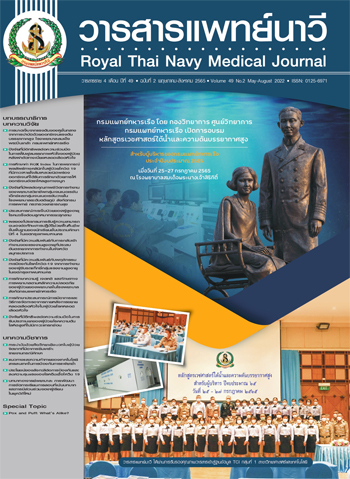ปัจจัยที่มีความสัมพันธ์กับพฤติกรรมการป้องกันโรคโควิด-19 จากการทำงานของผู้ขับรถแท็กซี่กลุ่มแรงงานสูงอายุ ในเขตกรุงเทพมหานคร
Main Article Content
บทคัดย่อ
การวิจัยครั้งนี้เป็นการวิจัยเชิงสำรวจแบบภาคตัดขวาง เพื่อศึกษาพฤติกรรมการป้องกันโรคโควิด-19 จากการทำงานของผู้ขับรถแท็กซี่กลุ่มแรงงานสูงอายุ ในเขตกรุงเทพมหานคร กลุ่มตัวอย่าง คือ ผู้ขับรถแท็กซี่อายุตั้งแต่ 45 ปีขึ้นไป ที่ขึ้นทะเบียนกับกรมการขนส่งทางบกในช่วงรอบปี 2563 จำนวน 346 คน โดยวิธีการสุ่มตัวอย่างแบบมีระบบ เก็บข้อมูลโดยใช้แบบสัมภาษณ์ มีค่าดัชนีความตรงของเนื้อหาเท่ากับ 0.96 และค่าความเที่ยงเท่ากับ 0.85 และ 0.73 วิเคราะห์ข้อมูลโดยใช้สถิติเชิงพรรณนา สถิติไคสแควร์ สถิติสัมประสิทธิ์สหสัมพันธ์ของเพียร์สัน และสถิติวิเคราะห์ถดถอยพหุคูณแบบขั้นตอน
ผลการวิจัย พบว่า กลุ่มตัวอย่างมีพฤติกรรมการป้องกันโรคโควิด-19 อยู่ในระดับสูง ร้อยละ 69.4 โดย 3 ปัจจัย คือ ความเชื่อด้านสุขภาพ ความเพียงพอของรายได้ และสถานภาพสมรส มีความสัมพันธ์กับพฤติกรรมการป้องกันโรคโควิด-19 และสามารถร่วมทำนายพฤติกรรมการป้องกันโรคโควิด-19 ได้ร้อยละ 28.9 (R2 = .289 p-value < .001)
ข้อเสนอแนะควรส่งเสริมพฤติกรรมการป้องกันโรคโควิด-19 ที่ตัวบุคคล โดยการเสริมสร้างความเชื่อด้านสุขภาพ เน้นด้านการลดเลี่ยงพฤติกรรมเสี่ยงและการป้องกันอันตรายส่วนบุคคล และบุคคลในครอบครัวควรให้การสนับสนุน
Article Details

อนุญาตภายใต้เงื่อนไข Creative Commons Attribution-NonCommercial-NoDerivatives 4.0 International License.
เอกสารอ้างอิง
Centre for the Administration of the Situation due to the Outbreak of the Communicable Disease Coronavirus (COVID-19). Progress on the situation of the novel coronavirus disease 2019 (COVID-19) in Thailand. [Internet]. [cited 2021 September 20]. Available from: https://news.thaipbs.or.th/content/3069 16. (in Thai).
Assumption University. Statistics on the use of public transportation in Bangkok. [Internet]. [cited 2021 September 20]. Available from: https://www.bltbangkok.com/poll/ 4055/. (in Thai).
Department of Disease Control. Coronavirus disease 2019 (COVID-19). [Internet]. [cited 2021 September 20]. Available from: https://ddc.moph.go.th/viralpneumonia/info.php.(in Thai).
Department of Disease Control. Guidelines for prevention and control of Coronavirus disease 2019 for domestic public transport. [Internet]. [cited 2021 September 20]. Available from: https://ddc.moph. go.th/viralpneumonia/file/measure/mea_bus_040363.pdf. (in Thai).
Department of Land Transport. Notification of action measures to control the spread of the Coronavirus 2019 for public transport operators. [Internet]. [cited 2021 September 20]. Available from: https://www.dlt.go.th/th/download.php?ref. (in Thai).
Bangkok Metropolitan Administration. Taxi service measures during the COVID-19 outbreak. [Internet]. [cited 2021 September 20]. Available from: https://www.facebook.com/information covid-19. (in Thai).
Administration Occupational Safety and Health. COVID-19 guidance for rideshare, taxi, and car service workers. [Internet]. [cited 2021 August 15]. Available from: https://www. osha.gov/sites/default /files/publications/OSHA4021.pdf.
American Public Transportation Association. The COVID-19 pandemic public transportation responds: safeguarding riders and employees. [Internet]. [cited 2021 August 15]. Available from: https://www. apta.com/wp-content/uploads/COVID-19_Transit_Guide_REVISON-2020_08_11.pdf.
International Air Transport Association. COVID-19: we will beat this crisis and reconnect our world. [Internet]. [cited 2021 August 15]. Available from: https://www.iata.org/.
Department for Transport. Guidance Coronavirus (COVID-19): taxis and PHVs. [Internet]. [cited 2021 August 15]. Available from: https://www.gov.uk/guidance/coronavirus -covid-19-taxis-and-phvs.
Jongrungrotsakul W, Chanprasit C, Kaewthummanukul T. Work-related health problems of taxi drivers in Chiang Mai province. Nursing Journal 2018;45:122-35. (in Thai).
Inma R, Jirapongsuwan A, Tipayamongkholgul M, Kalampakorn S. Factors related to hypertension among taxi drivers in Bangkok. Journal of Public Health Nursing 2017;31(3):39-54. (in Thai).
World Health Organization. Aging and working capacity: report of a WHO study group. [Internet]. [cited 2022 April 1]. Available from: https:// https://apps.who.int/iris/bitstream/handle/10665/36979 /924120835X-eng.pdf
Jirapongsuwan A. Work environment and health risk: principles and application for occupational health nursing. Bangkok: Danex Intercorporation; 2017. (in Thai).
Rosenstock IM. The health belief model and preventive health behavior. In: Becker MH, editor. The health belief model and personal behavior. New Jersey: Charles B. Slack; 1974.
Becker MH, Maiman LA. Sociobehavioral determinant of compliance with health and medical care recommendations. New Jersey: Charles B. Slack; 1975.
Firouzbakht M, Omidvar S, Firouzbakht S, Asadi A. COVID-19 preventive behaviors and influencing factors in the Iranian population; a web-based survey. BMC Public Health 2021;21(143):2-7. doi:10.1186/s12889-021-10201-4.
Li S, Feng B, Liao W, Pan W. Internet use, risk awareness, and demographic characteristics associated with engagement in preventive behaviors and testing: cross-sectional survey on COVID-19 in the United States. J Med Internet Res 2020;22(6):e19782. doi: 10.2196/19782.
Inthacharoen A, Kanchanapoom K, Tansakul K, Pattapat S. Factors influencing preventive behavior towards coronavirus disease 2019 among people in Khohong Town Municipality Songkhla province. Journal of Council of Community Public Health 2021;3(2):14-25. (in Thai).
Rad R, Mohseni S, Takhti H, Azad M, Shahabi, N, Aghamolaei T. Application of the protection motivation theory for predicting COVID-19 preventive behaviors in Hormozgan, Iran: a cross-sectional study. BMC Public Health 2021;21(1):1-11.
Siramaneerat I. Perceptions, knowledge and self-defense behaviors regarding COVID-19 among employees at Rajamangala University of Technology Thanyaburi, Thailand. Journal of Health Research 2021. doi:10.1108/jhr-09-2020-0426 10.1108/jhr-09-2020-0426.
Jaide C, Sansati S, Kongsaktrakul C. Factors related to child care workers’ behavior in prevention of acute respiratory infection in child care center. Ramathibodi Nursing Journal 2012;18(3):389-403. (in Thai).
Bashirian S, Jenabi E, Khazaei S, Barati M, Karimi-Shahanjarini A, Zareian S. Factors associated with preventive behaviours of COVID-19 among hospital staff in Iran in 2020: an application of the protection motivation theory. J Hosp Infect 2020;105(3):430-3.
Takdhada S. Fit, fake, faint in the cloud of fear for fencing with COVID-19, what’s the optimized? Royal Thai Navy Medical Journal 2021;48(3):771-6.
Juthawan J. COVID-19 preventative behavior of the staff in the National Institute of Health, Department of Medical Sciences. [Master’s Thesis, Faculty of Business Administration]. Ramkhamhaeng University; 2020. (in Thai).
Ruenbanthoeng S, Kalampakorn S, Jirapongsuwan A. Preventive behaviors of work related respiratory problem among railway construction workers in Bangkok. Journal of Public Health Nursing 2017;30(3):71-83. (in Thai).
Boonviset P, Damrongsak M, Harnirattisai T. Predictors of personal protection behaviors from incense dust exposure among incense makers. Nursing Journal 2013;40:80-90. (in Thai).
Potikul B, Kalampakorn S, Thiangthum W. Factors related to silicosis preventive behaviors of stone crushing worker in U-Thong, Suphanburi. In: The 15th Graduate Research Conferences 2014. Khon Kaen: Khon Kaen University; 2014. p. 1749-58 (in Thai).
Chalaemchart A, Sukserm T, Traithip T. Respiratory disease prevention behavior of people affected by small particles from the Northeastern sugar factory, Sam Chai District, Kalasin Province. In: The 8th NEU National Conference 2021. Khon Kaen: North Eastern University; 2021:736-47. (in Thai).
Promjame S, Kespichayawattana J. The effect of health belief model program on complication preventive behavior in hypertensive older persons. Royal Thai Navy Medical Journal 2018;45(3):561-77. (in Thai).

